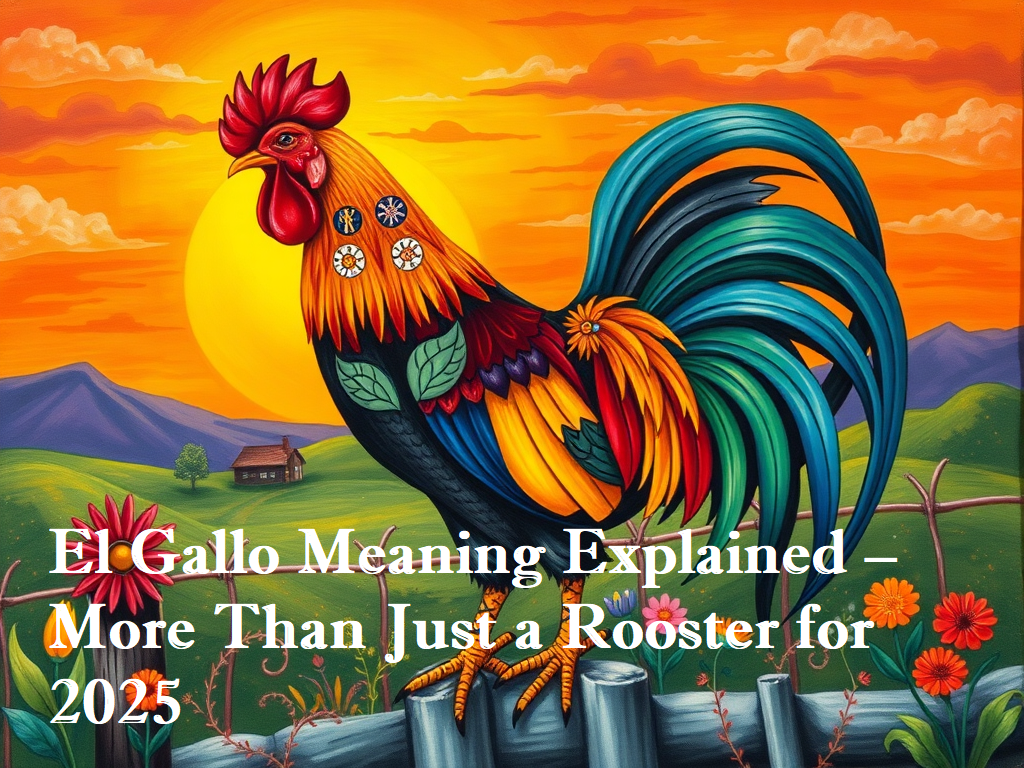El Gallo Meaning: El gallo (Spanish for “the rooster”) is a term that has different holds in symbolism, cosmology and syncretism across cultures, but especially in the countries that speak Spanish.
The term El Gallo resonates far beyond its literal translation of “the rooster” in Spanish. This powerful symbol carries deep cultural significance, rich folklore, and profound metaphor across Spanish culture, Mexican culture, and Latin American culture. From ancient historical references connecting roosters to vigilance and time, to modern interpretations in literature and media, El Gallo represents resilience and tenacity, identity and pride, and spiritual awareness.
In 2025, understanding El Gallo meaning encompasses everything from its role in traditional cuisine like Gallo en Mole to its presence in religious contexts and popular culture. Whether you’re exploring El Gallo meaning slang, searching for El Gallo meaning in Urdu, or wondering what does Gallo mean in Spanish, this comprehensive guide will unveil the multifaceted nature of this iconic symbol.
Literal Meaning of “El Gallo”
What Does “El Gallo” Mean?
El Gallo literally translates to “the rooster” in Spanish, derived from the Latin word “gallus.” The term represents the male chicken, known for its distinctive crow at dawn and proud demeanor. In Spanish culture, the rooster has been a household staple for centuries, serving both practical and symbolic purposes.
The word “gallo” appears in countless contexts throughout Spanish-speaking countries, from everyday conversation to profound literary works. When someone asks what does Gallo mean in Spanish, they’re touching upon a term that encompasses masculinity, leadership, and territorial dominance.
Phonetic Breakdown:
- El: [el] – The definite article “the”
- Gallo: [ˈɡa.ʎo] – Rooster, with the double “ll” pronounced as a “y” sound in most Spanish dialects
Gallo in English Google Translate provides the straightforward translation of “rooster” or “cock,” but this simple translation barely scratches the surface of its deeper meanings. The pronunciation varies across regions, with some areas maintaining the traditional “ll” sound while others adopt the more modern “y” pronunciation.
Symbolism and Cultural Significance of El Gallo
The Rooster as a Symbol of Strength and Courage
Throughout Mexican culture and broader Latin American culture, El Gallo embodies masculine virtues and leadership qualities. The rooster’s natural behavior of protecting its flock and territory has made it a universal symbol of strength, courage, and vigilance.
In rural communities, the rooster serves as nature’s alarm clock, announcing the dawn and symbolizing new beginnings. This connection to time and vigilance has elevated El Gallo beyond a mere farm animal to a representation of responsibility and dependability.
“El Gallo” in Folklore and Proverbs
Spanish proverbs featuring roosters reflect centuries of wisdom and observation:
- “Al gallo que canta, le tuercen el pescuezo” – “The rooster that sings gets its neck twisted” (Warning against boastfulness)
- “Gallo que no canta, algo tiene en la garganta” – “A rooster that doesn’t sing has something in its throat” (Suggesting hidden problems)
- “En casa del gaitero, todos son danzantes” – While not directly about roosters, this proverb reflects the hierarchy El Gallo represents
These folklore elements demonstrate how El Gallo has been woven into the fabric of Hispanic wisdom, serving as both cautionary tale and inspiration.
The Awakening of New Beginnings
The rooster’s crow at dawn symbolizes spiritual awareness and the triumph of light over darkness. In many cultures, El Gallo represents renewal, hope, and the promise of a fresh start. This symbolism extends to personal growth, spiritual awakening, and the courage to face new challenges.
El Gallo in Popular Culture
Music and Songs: The Rooster in Latin Music
Literature and media have embraced El Gallo as a powerful symbol. The legendary “El Gallo de Oro” (The Golden Rooster) by Vicente Fernández stands as one of the most celebrated songs incorporating rooster imagery. This classic ranchera song uses El Gallo as a metaphor for a proud, strong man who refuses to be tamed.
Famous Lyrics from “El Gallo de Oro”:
“Soy el gallo de oro que no se deja domar”
“I am the golden rooster that cannot be tamed”
This song exemplifies how El Gallo represents resilience and tenacity in the face of adversity. The artistic representation in music videos and live performances often features elaborate rooster imagery, reinforcing the symbolic connection.
“El Gallo” in Literature and Cinema
Mexican cinema has featured countless films where El Gallo serves as both literal and metaphorical element. From classic Golden Age films to modern productions, the rooster appears as a symbol of Mexican identity and pride.
Notable works include:
| Title | Year | Significance |
|---|---|---|
| El Gallo de Oro | 1964 | Classic Mexican film featuring rooster symbolism |
| El Gallo Colorado | 1948 | Early cinema exploring rural Mexican life |
| Various Ranchera Films | 1940s-1960s | Recurring rooster motifs in Mexican cinema |
Contemporary digital artwork and AI art continue to explore rooster themes, with modern artists using AI-generated images and computer-generated art to reinterpret El Gallo for new audiences.
“El Gallo” in Mexican Cuisine
Rooster Dishes in Mexico
Culinary traditions throughout Mexico feature rooster as a prized ingredient. Unlike regular chicken, rooster meat is considered more flavorful and is reserved for special occasions and traditional celebrations.
Gallo en Mole Recipe (Simplified):
Gallo en Mole represents one of Mexico’s most sophisticated role of roosters in culinary traditions:
Ingredients:
- 1 whole rooster, cut into pieces
- 20 dried chiles (combination of ancho, mulato, and pasilla)
- Chocolate tablets
- Sesame seeds
- Pumpkin seeds
- Spices (cinnamon, cloves, black pepper)
- Onion, garlic, tomatoes
Preparation:
- Toast and rehydrate the chiles
- Brown the rooster pieces
- Prepare the complex mole sauce with over 20 ingredients
- Simmer the rooster in mole for hours until tender
Festivals and Rooster Feasts
Día del Gallo (Rooster Day) celebrations occur throughout rural Mexico, where communities gather to prepare traditional rooster dishes. These festivals showcase the connection to Christianity and indigenous traditions, blending Catholic and pre-Hispanic elements.
“El Gallo” in Mexican Wrestling (Lucha Libre)
Mascot and Symbol of Fighters
Lucha Libre culture has embraced El Gallo as a symbol of fighting spirit. Many wrestlers adopt rooster-inspired personas, complete with elaborate costumes featuring feathers and rooster motifs.
Famous El Gallo wrestlers include:
- El Gallo Tapado (The Covered Rooster)
- Gallo de Jalisco (Rooster of Jalisco)
- El Gallo Colorado (The Red Rooster)
Iconography in Lucha Libre
The visual design of rooster-themed wrestlers incorporates traditional Mexican colors and patterns. Artwork generation for promotional materials often features dynamic rooster imagery, combining traditional symbolism with modern illustration techniques.
El Gallo as a Metaphor
The Rooster as a Fighter
When someone is called “El Gallo”, it suggests they possess fighting spirit and refuse to back down. This metaphor extends beyond physical confrontation to represent mental toughness and determination.
What does it mean to be El Gallo? encompasses:
- Leadership qualities
- Protective instincts
- Morning vigilance
- Territorial pride
- Unwavering courage
Popular Phrases and Idioms Involving “El Gallo”
El Gallo meaning slang varies by region, but common interpretations include:
- “Estar como gallo en corral ajeno” – Being like a rooster in someone else’s yard (feeling out of place)
- “Gallo viejo no aprende a cantar” – An old rooster doesn’t learn to sing (you can’t teach old dogs new tricks)
- “El gallo se conoce por el pico” – A rooster is known by its beak (people are judged by their actions)
El Gallo in Religion and Spirituality
The Rooster in Catholic Iconography
The connection to Christianity runs deep, with El Gallo appearing in Catholic iconography as a symbol of vigilance and resurrection. The rooster’s crow announced Peter’s denial of Christ, making it a reminder of human weakness and the need for spiritual awareness.
Symbolism in Catholic iconography includes:
- Vigilance against temptation
- The call to prayer at dawn
- Resurrection and new life
- Warning against spiritual complacency
Spiritual Significance of El Gallo
Beyond Catholicism, El Gallo represents spiritual awareness in various traditions. Indigenous Mexican beliefs view the rooster as a guardian spirit that protects against evil forces during the vulnerable pre-dawn hours.
The Role of “El Gallo” in Festivals and Traditions
Festivals Honoring the Rooster
Rooster symbolism in cultural celebrations appears throughout the Hispanic world:
Major Festivals:
| Festival | Location | Date | Significance |
|---|---|---|---|
| Fiesta del Gallo | Various Mexico regions | January | New Year celebrations |
| Día de San Pedro | Throughout Latin America | June 29 | Honoring roosters and fishermen |
| Carnival celebrations | Caribbean/Latin America | February/March | Rooster costumes and dances |
Rooster Symbolism in Cultural Celebrations
Art prompts for traditional festivals often feature El Gallo in ceremonial contexts, with elaborate feathered costumes and masks representing the rooster’s spiritual significance.
Global Perspectives on “El Gallo”
Rooster Symbolism Worldwide
While El Gallo holds special significance in Hispanic cultures, rooster symbolism worldwide reveals universal themes:
Cultural Comparisons:
| Culture | Rooster Symbolism | Significance |
|---|---|---|
| French | National symbol (Gallic rooster) | Pride and courage |
| Chinese | Zodiac animal | Honesty and confidence |
| Portuguese | Cultural icon | Luck and faith |
| Greek | Sacred to Apollo | Sun and prophecy |
Gallo meaning in French connects to the ancient Gauls, where the rooster became a national symbol representing French pride and resistance.
Modern Interpretations and Digital Culture
Contemporary creative AI and image generation tools have revolutionized how we visualize El Gallo. Artists use AI art platforms to create stunning artistic representation of roosters, blending traditional symbolism with modern aesthetics.
Digital artwork featuring El Gallo includes:
- NFT collections celebrating rooster imagery
- Social media art celebrating Hispanic heritage
- Gaming avatars inspired by rooster symbolism
- Fashion designs incorporating El Gallo motifs
El Gallo meaning urban dictionary definitions reflect how younger generations interpret this traditional symbol, often emphasizing strength, authenticity, and cultural pride.
Celebrity Connections and Modern References
While exploring El Gallo meaning Jake Paul might seem unusual, the connection lies in the fighting spirit that both represent. Professional fighters and celebrities who embody the rooster’s characteristics of confidence and territorial behavior often earn comparisons to El Gallo.
Interestingly, combat sports figures like those with substantial earnings (comparable to Mike Tyson net worth of approximately $10 million and Jake Paul net worth estimated at $80 million) often adopt animal-inspired personas that echo the El Gallo tradition.
Mike Tyson record of 50 wins (44 by KO) and 6 losses exemplifies the fighting spirit that El Gallo represents, though without direct cultural connection.
Regional Variations and Interpretations
El Gallo meaning in Urdu doesn’t have a direct translation but conceptually aligns with similar bird symbolism found in South Asian cultures, where roosters represent bravery and dawn’s arrival.
What does Gallo stand for? varies by context:
- In surnames: Often indicating ancestral connection to rooster breeding
- In business: Representing reliability and early service
- In sports: Symbolizing fighting spirit and determination
Pico de Gallo meaning relates to the popular Mexican salsa, literally translating to “rooster’s beak,” named for its fresh, sharp flavor that “pecks” at the palate.
Contemporary Cultural Impact
What does the Gallo symbolize? in modern contexts extends to:
- Corporate branding: Companies using rooster imagery to convey reliability
- Social movements: Groups adopting El Gallo to represent resistance
- Personal identity: Individuals embracing rooster symbolism for strength
- Cultural preservation: Communities maintaining rooster traditions
The evolution of El Gallo symbolism demonstrates how traditional meanings adapt to contemporary contexts while maintaining core values of strength, courage, and identity and pride.
Conclusion
El Gallo transcends its literal meaning as “the rooster” to embody a rich tapestry of cultural significance, symbolism, and metaphor that spans centuries and continents. From its roots in Spanish culture and Mexican culture to its global interpretations, El Gallo represents universal values of resilience and tenacity, spiritual awareness, and identity and pride.
Whether encountered in traditional folklore, celebrated in literature and media like “El Gallo de Oro”, savored in culinary masterpieces like Gallo en Mole, or honored in religious Catholic iconography, the rooster’s symbolic power endures. Modern interpretations through digital artwork, AI art, and creative AI continue to evolve this ancient symbol for new generations.
Understanding El Gallo meaning in 2025 requires appreciating both its historical references connecting to role of roosters in rural life and its contemporary applications in everything from Lucha Libre to festivals celebrating rooster symbolism in cultural celebrations. The symbol’s persistence across cultures—from Gallo meaning in French national identity to its spiritual significance in various traditions—demonstrates its universal appeal.
As we move forward, El Gallo continues to inspire artistic representation, influence culinary traditions, and serve as a powerful metaphor for those who refuse to be silenced or subdued. The rooster’s crow still announces new beginnings, just as it has for millennia, reminding us that some symbols transcend time, language, and cultural boundaries to speak to the human spirit itself.
In exploring what does it mean to be El Gallo, we discover not just the meaning of a word, but the embodiment of courage, the celebration of heritage, and the eternal promise that dawn will always break, no matter how dark the night may seem.

Catherine Frank, founder of BiblicalHorizon.com, shares daily prayers and Bible verses to nurture spiritual growth. With a lifelong passion for scripture and prayer traditions, she creates accessible spiritual content that resonates with both seasoned believers and newcomers seeking divine connection.



